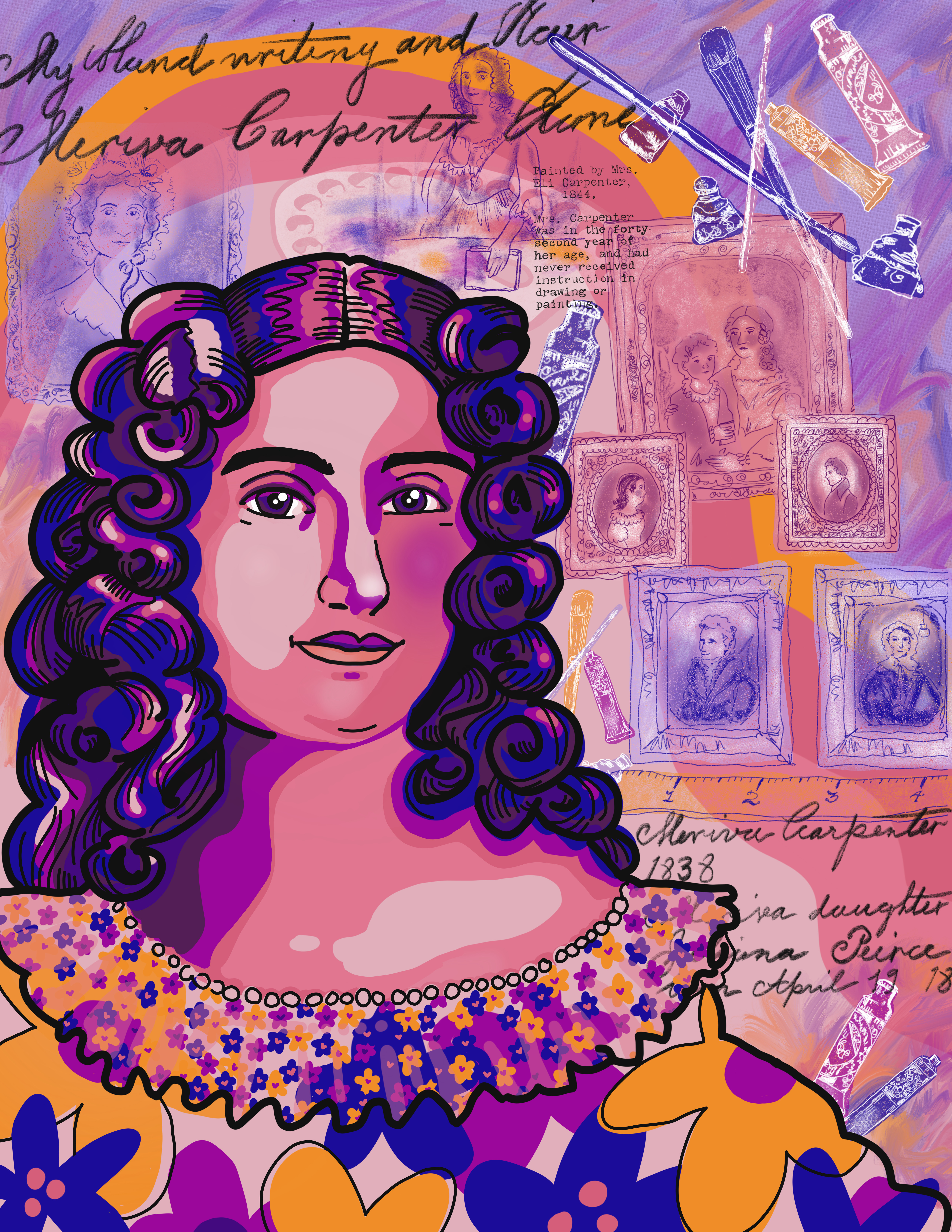
How can we know so little about someone who left behind so much? That is the question I often ask myself when I consider what we know about miniature portrait artist, Meriva Carpenter. Carpenter provided inspiration for local artist Molly Reagan for her “History Highlighted” series created for Cortland County Historical Society. This project is made possible with funds from the Statewide Community Regrants Program, a regrant program of the New York State Council on the Arts with the support of the Office of the Governor and the New York State Legislature and administered by CNY Arts.
Meriva Carpenter was born to Dr. Ruggles and Juliana Pierce Carpenter in 1802. Sources indicate that Meriva was born in Connecticut and that her family moved to Massachusetts around 1815. On February 27, 1820, she married Eli Carpenter in Tolland, Connecticut. Eli was her first cousin. Eli Carpenter was born in 1794 or 1795 in New Hampshire to Eli and Abigail Baker Carpenter. Young Eli Carpenter came to Homer around 1816 when he bought a share in the water privilege and land at East River (later known as Carpenterville) from pioneer settler Daniel Crandall. Crandall had erected the first saw-mill in East River in 1800. Here Eli Carpenter put up a fulling mill and a facility for dyeing and dressing cloth, including a carding machine. His business prospered for many years at this location, during which time he extended his business to include the manufacture of carpets which he dyed himself. In around 1835 or 1836, Eli became the sole owner of the site and waterpower, and he built new mills.
Sometime between his arrival in 1816 and his subsequent marriage to Meriva in 1820, Eli must have courted his younger cousin. They were married in Tolland, Connecticut in February and removed to Homer, New York in March. Meriva and Eli were married for 43 years, until Eli’s death in 1863. During their time together, they had three children: Malvina Marcianna, Marius Volney, and Henri Lamoran. Their home at East River was a beautiful house built by Eli to withstand the test of time. Later owners found six inch beams on the exterior when they tried to put in a window. Beautifully arranged gardens and an orchard surrounded the home and were a source of pride, and the interior of the home was said to have been filled with “relics, rare furniture, and china.” The Carpenter home is likely where Meriva painted many of her miniature portraits. (Note: This house was completely destroyed by a fire in around 1917.)
We don’t know anything about Meriva Carpenter’s years before her marriage in 1820 and virtually nothing about her life afterward. Carpenter was a self-taught artist according to information at Cortland County Historical Society. She must have learned early on to paint miniatures because one of her self portraits is said to be of her at 15. We have tantalizing handwritten notes in the Eli Carpenter family file that indicate that sometime in the past, there were a number of local people who collected Meriva’s miniatures along with clues about her family and her work. Unfortunately, there’s not enough to prove much! There are many notes on the handwritten family tree in the file that indicate relatives that were painted by Meriva, so that is a starting point for us. We have some of those portraits indicated, and Meriva was meticulous about identifying both the sitter and herself as well as the date the portrait was done. She very often included a lock of the sitter’s hair. As mentioned, many of the known portraits are members of the Carpenter family, nuclear and extended.
In the 1990s, a trunk of Carpenter family artifacts was presented to CCHS and within was a true treasure trove of history. The trunk contained artifacts and clothing dating back to the 1700s! This time capsule was stored at a local bank and forgotten when the guardian of family history died in the 1930s. Inside the trunk was an authentic bloomer costume from the 1850s, one of two known examples currently in existence in the United States. We have not been able to confidently say if this ensemble was Meriva’s or her daughter Malvina, who was also an artist and skilled taxidermist. We will probably never know the answer unless more information comes to light. The thing with history is that you never do know when a missing piece of the puzzle will be discovered. Hunting for history is tremendously rewarding, and I hope that one day we can solve some of the mysteries surrounding Meriva Carpenter’s life. ~Tabitha
